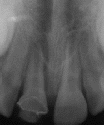Apexification
An 8 year old male patient was referred to our office, approximately
6 months after suffering a traumatic injury. There was a pulp exposure
which occurred as a result of the trauma. His had performed a pulpotomy
and placed a temporary crown at that time. The patient now complained of
a 'hurting' feeling. As well, the tooth was sensitive when chewing.
CLINICALLY:
There was some swelling in the buccal fold area of tooth #11. The tooth
was slightly mobile. Perio pocketing was within the normal range. The patient
was not sensitive to temperature testing: Hot or cold stimulus evoked no
response. Nor was there a response to the electric pulp tester. Tooth #11
was sensitive to percussion.
RADIOGRAPHICALLY:
A pre-op radiograph of tooth #11 revealed an incompletely formed root
and an open apex. There was a wider root-canal in the apical portion than
the coronal aspect. A large vague radiolucency was also present. It was
interesting to see the thinness of the root of the adjacent tooth, the
lateral incisor.
TREATMENT:
The patient, together with his parents, were informed that endodontic
therapy would now be required to try and save this tooth. However, due
to the complications of the open apex, apexification procedures would also
be required to try and create some type of apical closure. Once this would
occur, completion of endodontic therapy (i.e. obturation) would be attempted.
The patient's parent understood that apexification techniques were not
always predictable, both in time limit, and success. However given the
options, both were interested in trying to save this tooth.
The patient was anesthetized. A rubber dam was placed. A straight line
access cavity was established into the pulp chamber using a tapered, diamond
bur. A bad odor emanated from the root-canal system, and no pulpal vitality
was encountered. The root-canal system was carefully cleansed with files
and gates glidden burrs. Care was taken not to damage the fine, thin apical
walls.
The canal was dried with (large, multiple) paper points. Knowing the
length of the canal, CaOH was injected into the root-canal system. Care
was taken to prevent extrusion of this material through the apex, while
still providing for a dense fill inside the root itself. The coronal opening
was sealed and the patient was instructed to return 4-5 months later.
4 months later a radiograph was taken. No real change was observed.
The patient was asymptomatic. Once again the patient was anesthetized,
the rubber dam was placed, and access was gained into the root-canal system.
Copious irrigation with NaoCl, together with light cleaning & shaping
removed the remaining CaOH. The canal was dried, and CaOH was again placed
into the root-canal system.



This was repeated on two other occasions: At this time, the radiograph
demonstrated some apical closure, which was confirmed by delicate cleaning
& shaping. This barrier was short of the radiographic apex, however
in this case, there was no attempt to negotiate through this to the radiographic
apex. A custom-rolled gutta-percha cone (due to the width of the root-canal
system), together with Kerr Sealer, was used to obturate this tooth, using
the Warm Gutta-Percha Technique.
DISCUSSION:
After obturation, it was obvious that the wide canal narrowed drastically,
but continued to the end of the root and was in communication with the
attachment apparatus. This was not evident when probing within the root-canal
system: The apical portion of the canal appeared completely occluded.
This case further demonstrates the importance of obturation with a warmed,
softened material (gutta- percha) which, when under pressure, will flow
into very fine areas. As the hydrostatic pressure forces gutta-percha into
these areas, it pushes any remaining organic material out from the (avascularized)
root into the (vascularized) attachment apparatus. The body will destroy
this organic material without consequence. The canal is now sealed from
this attachment apparatus in three dimensions, and the area will continue
to heal. I feel that if lateral condensation were used to obturate this
tooth, the same result would not have been attained: There would not be
a similar build-up of apical pressure forcing gutta- percha to flow into
this fine apical conduit.
|

